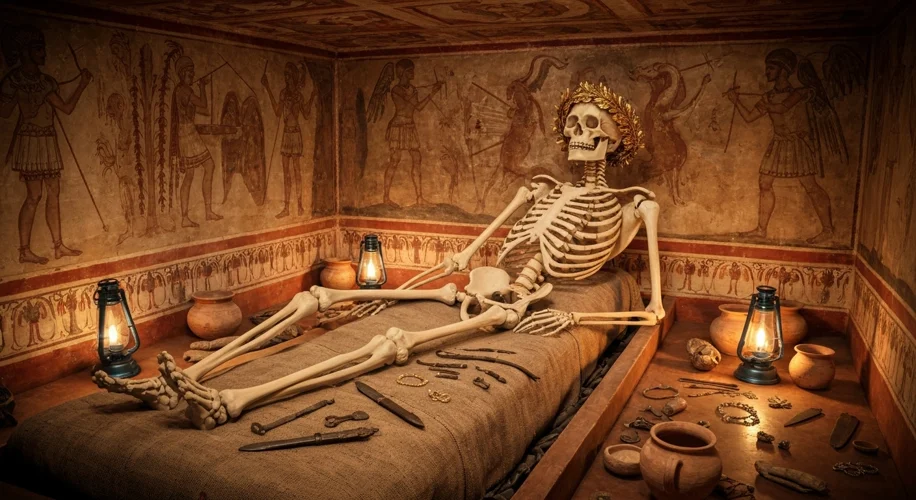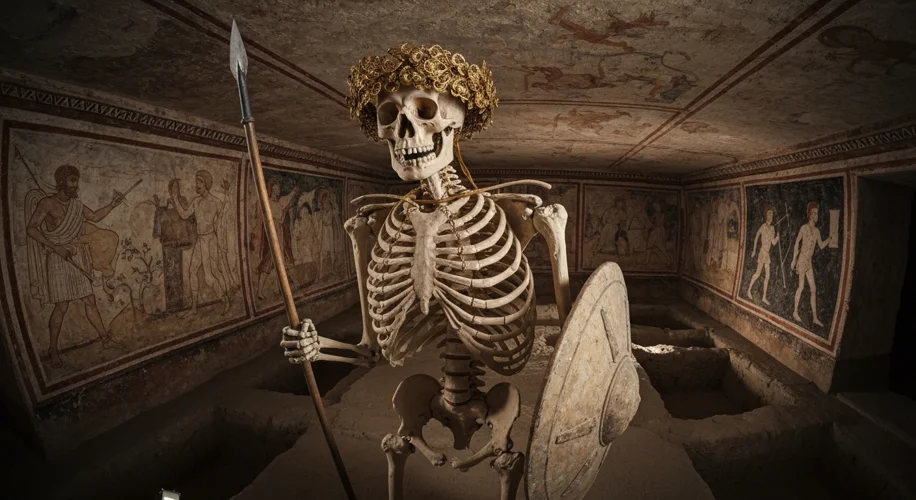The wind whips across the windswept plains of Sakar, Bulgaria, carrying whispers of a forgotten past. For over two millennia, the earth has guarded its secrets, until now. Archaeologists have unearthed the remarkably preserved remains of a Thracian warrior, a figure so commanding in life that he has been posthumously nicknamed the ‘Lord of Sakar.’
The discovery, made public on September 10, 2025, is not merely the uncovering of bones; it is the unveiling of a life lived with power, prestige, and a deep connection to the spiritual world. The warrior, estimated to have lived over 2,100 years ago, was found in a tomb that speaks volumes about the wealth and artistry of the Thracian civilization. At the center of this ancient burial lay a stunningly intricate gold wreath, a testament to the advanced metallurgical skills and the symbolic importance of funerary rites in this ancient culture.
The Thracians, a collection of tribes who inhabited the southeastern Balkan Peninsula, were renowned for their warrior ethos, their sophisticated craftsmanship, and their vibrant religious practices. They left behind a rich legacy, from the epic poems of Homer to the intricate gold treasures unearthed in burial mounds. This particular warrior, however, stands out. His burial site suggests a man of considerable status, perhaps a chieftain or a highly decorated military leader, whose final resting place was adorned with the finest materials imaginable.

The gold wreath itself is a masterpiece of ancient goldsmithing. Fashioned from thin sheets of hammered gold, it depicts a series of leaves and perhaps floral motifs, meticulously crafted to represent both the natural world and the eternal cycle of life and death. Such wreaths were not merely decorative; they were imbued with profound meaning, often symbolizing victory, divinity, and the warrior’s passage into the afterlife. For the Thracians, gold was not just a precious metal but a sacred substance, believed to possess magical properties and to connect the earthly realm with the divine.
Unearthing such a tomb is like opening a window into a lost world. The careful placement of the body, the surrounding grave goods, and the opulent wreath all provide clues about Thracian beliefs concerning death and the afterlife. They believed that the journey to the next world required preparation and that the deceased would continue to exist in some form, needing provisions and symbols of their earthly status. The ‘Lord of Sakar’ was clearly intended to carry his status and his connection to the gods into eternity.
The discovery also underscores the vastness of our historical understanding. While much is known about the Greeks and Romans, the Thracians, despite their influence and proximity, remain somewhat enigmatic. Each new find like this helps to piece together the complex tapestry of ancient European history. It challenges preconceived notions and reveals the diversity of cultures that flourished in this region millennia ago.
The ‘Lord of Sakar’ joins a pantheon of magnificent Thracian finds, such as the treasures discovered at Panagyurishte and Varna. Each artifact, whether a golden rhyton or an ornate burial wreath, tells a story of a society that deeply valued artistry, martial prowess, and spiritual devotion. This latest discovery promises to add another rich chapter to our understanding of these fascinating ancient people, reminding us that history is a continuous excavation, with new wonders waiting to be unearthed from the silent earth.

